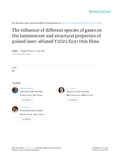| dc.description.abstract | Y2O2S:Eu3+ films have been grown on Si (100) substrates by using a pulsed laser deposition technique. The thin films grown under vacuum, argon and oxygen ambient have been characterized using structural and luminescent measurements. The X-ray diffraction patterns showed mixed phases of cubic and hexagonal crystal structures. The crystallinity of the film deposited in vacuum is poor, but improved significantly in argon and oxygen atmosphere. Similarly, both scanning electron microscopy and atomic force microscopy confirmed that different species of gases affected the morphology of the films. The average band gap of the films calculated from diffuse reflectance spectra using the Kubelka–Munk function was about 4.69eV. The photoluminescence measurements indicated red emission of Y2O2S:Eu3+ thin films with the most intense peak appearing at 612 nm, which is assigned to the 5D0–7F2 transition ofEu3+.The intensities of this most intense peak greatly depend on the species of gas with argon having the highest peak. This phosphor has applications in the flat panel displays. | en_US |

